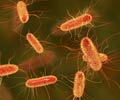Duke University scientists, have by using enzymes from E. coli bacteria, introduced a hundred-fold improvement in the precision of features imprinted to create microdevices such as labs-on-a-chip.
The inkless microcontact printing technique can imprint details measuring close to one nanometer, or billionths of a metre, the team from the University’s Pratt School of Engineering reported in the Sept. 24, 2007 issue of the Journal of Organic Chemistry.“This has a lot of potential, because we don't have the resolution issue,” said Robert Clark, a professor of mechanical engineering and materials science and dean at Duke.
“The really important part is that with a biological catalyst there’s no ink involved,” added Duke chemistry professor Eric Toone.
In traditional microcontact printing – also called soft lithography or microstamping – an elastic stamp’s end is cast from a mould created via photolithograpy – a technique used to generate microscopic patterns with light.
Those patterns are then transferred to a surface by employing various biomolecules as inks, rather like a rubber stamp.
A shortcoming of traditional microcontact printing is that pattern transfer relies on the diffusion of ink from the stamp to the surface. This same diffusion spreads out beyond the limits of the pattern as the stamp touches the surface, degrading resolution and blurring the feature edges.
Advertisement
As part of the experiment, Prof. Clark and graduate student Matthew Johannes crafted a microstamp out of a gel-like material called polyacrylamide, which compresses more uniformly than the silicone material known as PDMS, which is normally used in microstamping.
Advertisement
For this proof-of-principle demonstration, Prof. Toone’s team chose biological enzyme exonuclease I, derived from the bacterium E. coli, as a catalyst.
In one set of experiments, the polyacrylamide stamp pattern bearing the tethered enzymes was pressed on a surface of gold previously covered with a uniform coating of single-stranded DNA molecules.
The DNA molecules were also linked to fluorescent dye molecules to make the coating visible under a microscope.
The team found that wherever the enzyme met the DNA, the end of the DNA chain and its attached dye were broken off and removed. This created a dye-less pattern of dots on the DNA coating, with each dot measuring about 10 millionths of a metre diameter.
Findings further revealed very precise microdots, as the catalyst that created them could not shift their position more than the length of its chemical tether – less than one nanometer.
“Whether the stamp was left on for a short period of time, or for days, the pattern did not change,” said Prof. Clark.
He said the inkless microstamp could also re-use the same suspended catalyst molecule repeatedly.
“Enzymes can deteriorate with extended use. But because of our tether attachment chemistry, we can easily wash the old enzyme off, put on a new one and keep going,” Prof. Clark said.
In follow-up research, Prof. Clark and Prof. Toone are evaluating more durable microstamping materials attached to longer lasting catalysts that are non-enzymatic.
They say that by using different catalysts in succession, future versions of the inkless technique could be used to build complex nanoscale devices with unprecedented precision.
“Soft lithography has really revolutionized the field of surface science over the last 30 years. And I honestly believe that using catalysts instead of diffusive processes is going to become the way that soft lithography is done in the future,” said Prof. Toone.
Source-ANI
SRM






